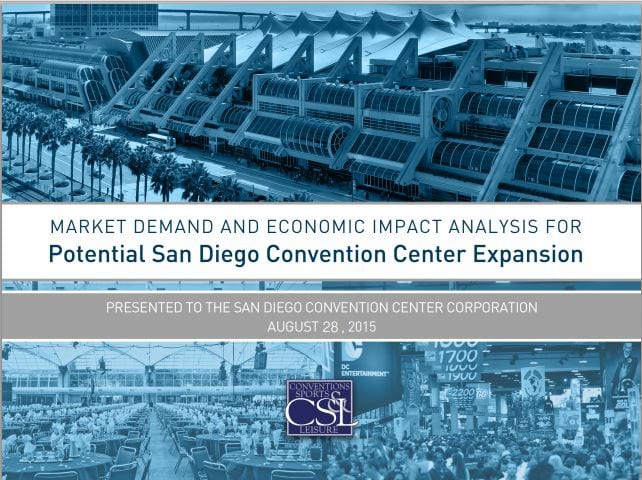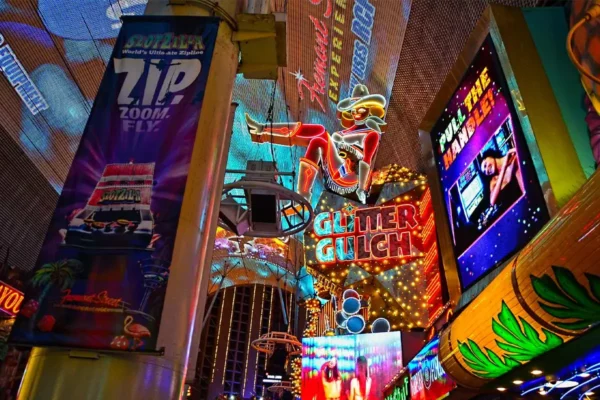A contiguous expansion of the San Diego Convention Center (SDCC) is preferred by the center’s clients and stakeholders and also provides the greatest return on investment for the City of San Diego, according to a new study by Conventions, Sports and Leisure International (CSL).
The study analyzed the financial and economic value of expanding the convention center with contiguous exhibit space as well as an expansion several blocks from the current facility characterized as non-contiguous or a “campus” option.
While the contiguous expansion was deemed superior, the study found that the City would also benefit from additional meeting and exhibit space from a non-contiguous expansion. “From an impact return perspective, the City should continue to pursue the contiguous option as opposed to a significant investment in a publicly-owned convention center located several blocks from the existing SDCC,” said John Kaatz, the study author.
In addition to pursuing the contiguous expansion of the current SDCC, Kaatz said the City should consider some type of support for a development of a largely privately-led hotel and convention project on or near the site currently identified for the campus option. “The strength of the San Diego market for mid-sized conventions, as well as the importance of securing additional headquarter hotel inventory, suggests that multiple projects designed to maintain and enhance the competitive position of the San Diego market could be pursued.”
“Expanding the convention center will create new jobs for San Diegans and provide a huge economic benefit to our region. This study reaffirms that the contiguous expansion is the ideal approach for the most immediate impact, and provides the best return on investment,” said Mayor Kevin L. Faulconer. “It’s time to expand the convention center. My administration will begin talks with the tourism industry, City Council and other stakeholders to lay the groundwork for moving forward with the contiguous project in 2016 if the City prevails in court. The campus expansion and accompanying hotel would also bring economic benefits for the city that we will continue to explore.”
An ongoing legal challenge to the Coastal Commission’s approval of the contiguous expansion project may be resolved in the next six months.
Three Options Studied
The study analyzed the current state of the convention and meetings industry and San Diego’s market position within the industry as well as the various expansion options, including:
- Option A: The contiguous option included an addition of 210,000 square feet of exhibit space, 100,000 square feet of meeting space and a new 55,000-square-foot ballroom connected to the current convention center.
- Option B: The campus option included analysis of a 225,000-square-foot exhibit hall on one level.
- Option C: A campus design that stacked the exhibit halls on two levels each with an additional 80,000 square feet of meeting space and an 80,000-square-foot ballroom. While Option C would fit on the current Tailgate Park location it was largely rejected by clients as unworkable.
- The study included event planner focus group sessions in Chicago and Washington, D.C., and phone and email surveys of 200 current, past and potential SDCCC customers. In addition, meetings with key stakeholders from the hospitality industry, the Port of San Diego, elected officials and others were held in San Diego.
“San Diego continues to be a top meeting and convention destination and the one thing this study has shown us again is that if we build it, they will come,” said Stephen Cushman, special assistant to Mayor Kevin Faulconer and Chair of the San Diego Convention Center Board. “The demand for exhibit and meeting space in San Diego remains strong and the only way we capture more attendees, hotel room nights, and economic impact is if we build more meeting and convention space.”
SDCC Occupancy/Market Demand Remain High
- The study found that issues with “space and date availability” were cited as the most prominent reason for not booking an event in San Diego which could indicate “unmet demand for SDCC facilities.”
- SDCC has “consistently high overall occupancy” and the “high occupancy in the shoulder months of January/February and June through August are unusual in the convention industry, and likely reflect the significant appeal of San Diego as an event destination.”
- In 2014, excluding major holidays, there were only four blocks of at least eight days with 200,000 square feet of unoccupied SDCC exhibit space. A similar analysis shows that there was only one eight-day block of SDCC exhibit space in 2014 that could accommodate an additional event requiring up to 400,000 square feet. As a result, the report states, “the ability to secure added large convention and tradeshow event activity in San Diego will clearly require added exhibit space capacity.”
- SDCC experienced its highest attendee day figure over the past seven years in 2009 and attendance has held relatively constant over the past six years. This consistency suggests that the SDCC has reached a mature level of event activity, with a need for some type of product enhancement in order to materially increase attendee days and associated room night generation and economic impact.
- The study also “highlights the importance of considering future hotel development in unison with any future SDCC expansion scenario in order to maintain San Diego’s competitive advantage as a destination.”
Other Key Findings
- The survey and focus group research demonstrates what the study calls “the superiority of the contiguous option” for many of the clients who use the full building as it exists.
- From a market share capture, a contiguous expansion that brings the Convention Center to a total of 700,000 square feet of exhibit space could accommodate 81 percent of the national market while a 225,000 square foot campus facility could accommodate 47 percent. The current SDCC can accommodate 70 percent of the current attendee base.
- A campus model provides “somewhat less flexibility” in attracting events of varying sizes, compared to a contiguous option in which two overlapping events requiring 300,000 square feet of space could be housed. CSL’s findings estimate that 11 percent of the national convention attendee base requires 525,000 to 700,000 square feet of exhibit space.
- Under a campus model, the study states “it is likely that non-local events using the new space will require use of the new adjacent 1,600 room hotel.”
“The confirmation that a contiguous expansion of the San Diego Convention Center will ensure the facility’s long term viability is good news. As I have in the past, I support the contiguous expansion as a means of attracting large-scale conventions to our city and generating jobs and economic benefit for our neighborhoods,” said Councilmember Todd Gloria. “I look forward to the resolution of financial and legal questions so San Diego’s most critical civic project can be completed.”
The last comprehensive market study relating to a proposed expansion was completed in 2009 for then-Mayor Jerry Sanders’ Task Force. A $520 million contiguous expansion of the SDCC was approved by the California Coastal Commission in October 2013, but the project stalled after the financing mechanism was ruled unconstitutional in August 2014. The CSL study was commissioned by the SDCC and the City of San Diego to update the 2009 market and demand analysis for a proposed expansion.
Read the complete CSL Expansion Study here.






























